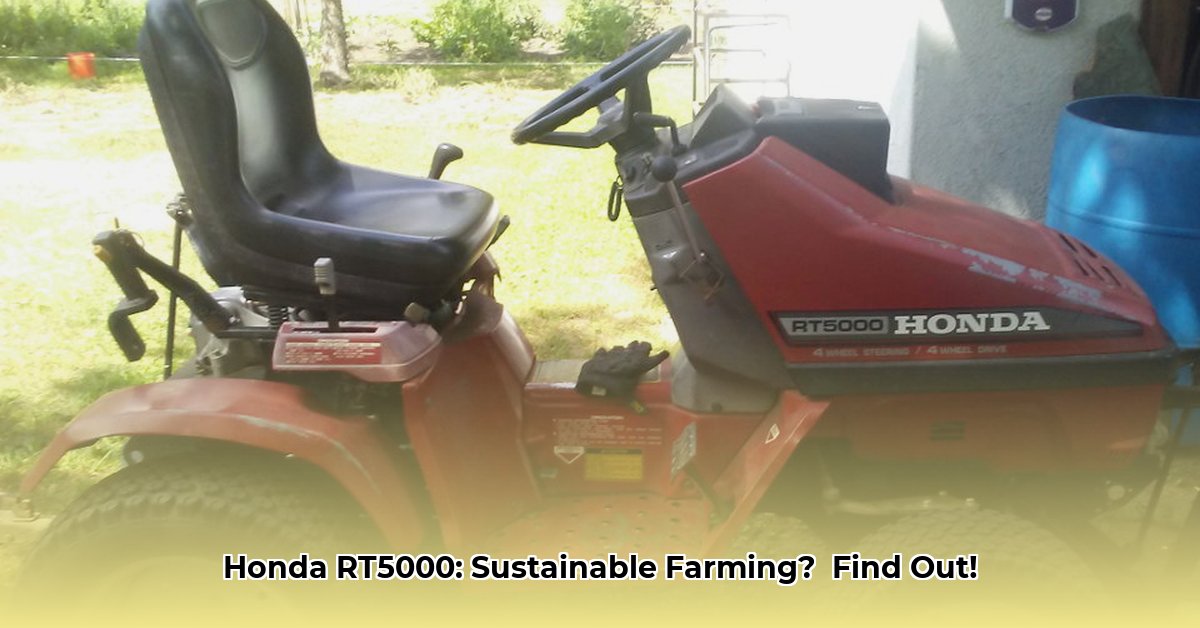
The Honda RT5000 tractor: a compact machine potentially suited for smaller farms, but is it a truly sustainable choice in modern agriculture? This review analyzes its suitability for sustainable small-scale farming, weighing its advantages against the challenges posed by its age and discontinued status. For more sustainable alternatives, explore electric options.
Fuel Efficiency and Operational Costs
The RT5000 boasts a 2.2-gallon fuel tank, suggesting potential fuel economy. However, direct comparisons with modern, energy-efficient tractors are needed to determine its true fuel efficiency per acre cultivated. This is crucial for assessing its economic and environmental sustainability. Aren't lower fuel consumption and reduced emissions key factors in sustainable farming practices? This lack of data hinders a definitive assessment of its long-term operational costs.
Multi-Functionality and Year-Round Use
The RT5000's adaptability is a significant advantage. Compatible attachments, such as a 46-inch mower deck and snow blower, enable year-round use. This multi-functionality reduces the need for multiple specialized machines, minimizing capital investment, storage space, and the environmental impact associated with manufacturing and transportation of additional equipment. This directly contributes to a more sustainable farming operation.
Compact Design and Soil Health
Its compact design—a 47.8-inch wheelbase and a weight of 959 lbs—minimizes soil compaction. Preserving soil health is paramount for long-term agricultural sustainability. The RT5000's reduced ground pressure directly supports this goal, contributing to better soil structure and overall land health. Does this reduced compaction translate into improved yields and reduced need for additional soil amendments? Further research could quantify these benefits.
Challenges of Age: Parts, Repairs, and Emissions
The RT5000's age presents significant challenges. As a discontinued model, sourcing replacement parts is likely to be difficult and expensive, leading to potential downtime and increased repair costs. Furthermore, its lack of modern emission controls results in a greater environmental impact compared to newer machines. This raises serious questions about its long-term sustainability. Can the RT5000 truly be considered a sustainable choice with these limitations?
Sustainability Assessment: Weighing the Pros and Cons
The Honda RT5000 presents a complex sustainability equation. While its compact design and potential fuel efficiency are beneficial, the limitations posed by its age, particularly regarding parts availability and emissions, must be carefully considered. A full lifecycle assessment (LCA) would provide a more comprehensive evaluation of its overall environmental impact.
Actionable Steps for Stakeholders
The following steps outline practical actions for various stakeholders involved in the decision-making process surrounding the use of the Honda RT5000:
Small-Scale Farmers: Thoroughly investigate parts availability and potential repair costs before purchase. Consider modern, sustainable alternatives and conduct a comprehensive cost-benefit analysis which includes total cost of ownership.
Equipment Manufacturers: Analyze the RT5000's design for inspiration in developing future sustainable models, prioritizing fuel efficiency, multi-functionality, and extended lifespan. Invest in research and development of electric or hybrid farming equipment options.
Policy Makers: Implement policies supporting sustainable agricultural technologies and the transition away from outdated equipment. Consider financial incentives to assist farmers in this transition.
Researchers: Conduct comprehensive LCAs of agricultural equipment to accurately compare their environmental impact and guide the development of more sustainable alternatives.
Risk Assessment and Mitigation Strategies
The following table outlines potential risks associated with using the RT5000 along with effective mitigation strategies:
| Risk Factor | Likelihood | Impact | Mitigation Strategy |
|---|---|---|---|
| Parts Availability | High | High | Secure a reliable parts supplier; prioritize regular preventative maintenance; consider keeping a stock of common parts. |
| Repair Costs | High | Medium | Conduct a thorough pre-purchase inspection; budget for potential repairs and unexpected expenses. |
| Emission Impact | Medium | Medium | Investigate carbon offset programs; consider alternative, cleaner machines. |
| Technological Obsolescence | High | Medium | Explore modern alternatives with enhanced features and better parts availability; weigh the cost-benefit implications of different options. |
Regulatory Compliance
Ensure compliance with all local and national regulations regarding emissions, noise levels, and safety standards before operating the RT5000.
Conclusion: A Balanced Perspective
The Honda RT5000 presents a nuanced case. Its compact design and potential fuel efficiency align with some aspects of sustainable agriculture. However, the challenges posed by its age, particularly parts availability and emissions, cannot be overlooked. A careful and comprehensive evaluation, including a thorough cost-benefit analysis, is critical before adopting this vintage tractor for sustainable farming practices. Considering modern alternatives with their inherent advantages should be a priority for informed decision-making. The long-term sustainability of any farming equipment requires a holistic approach considering both economic and environmental factors.